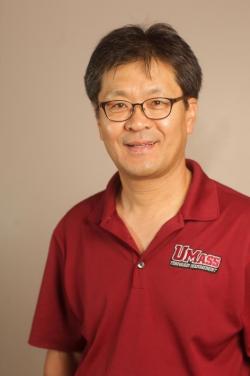
The Grass is Always Greener
When you think of something ‘green,’ both money and turfgrass might come to mind. In the case of Geunhwa Jung, you would be right on both counts, sort of. Professor Jung, a turfgrass specialist at the University of Massachusetts Amherst, researches a fungal turf pathogen nicknamed dollar spot (get it?). This pathogen is a fairly common problem in the U.S. on large swathes of green grass, such as home lawns and golf courses. It results in unsightly patches of round, straw-colored sunken spots about the size of a silver dollar. It is of importance to experts such as Jung because a golf course superintendent will apply greater amounts of chemicals than environmentally ideal and typically spend 60-75% of their chemical budgets on treatments to eradicate it, money that could be put to better use in maintenance.
Jung is a professor and researcher specializing in turfgrass diseases, but his background is as a plant breeder and geneticist. Since his arrival at UMass in 2006, Jung has been researching basic and applied aspects of two specific turfgrass diseases: dollar spot and snow molds (significant pests in regions where deep snows cover the land.) His overarching goal is to research important problems facing the turf industry and to provide insight on the biology and management of important turfgrass pathogens. Jung develops integrated pest management strategies facilities that include park, athletic and sports turfgrass.
Jung frequently makes presentations at professional educational programs both nationally and internationally, including those for lawn care companies, municipal turf managers, homeowners, and golf course superintendent associations. He also provides lectures for the UMass Winter School for Turf Managers.
Research and Extension Programs
Jung's research and extension programs focus on providing clientele with economically and environmentally-sound disease control strategies. His long-term goal is to focus on developing improved, disease-resistant turfgrasses such as creeping bentgrass and ryegrass using classical and molecular methods. Specifically, he is currently studying the mechanisms of host resistance to turfgrass fungal diseases by estimating location, number, and effect of the disease-resistant genes using innovative DNA marker technology. For that purpose, he has developed the first genetic linkage map (which acts as a road map) in creeping bentgrass, which has been utilized for locating dollar spot resistance genes so that breeding for disease-resistance can be efficiently facilitated. Jung has received recognition nationally and internationally for his work with DNA marker technology. His laboratory provides fee-based DNA fingerprinting services of turfgrass varieties to clients from all over the world.
He creates an integrated disease management strategy for turfgrass managers by testing new biological and chemical products at sites and then experimenting with new practices to reduce turf diseases. Regarding his basic research, Jung concentrates on two areas. The first is to better understand microbial diversity on soils and thatch of organically and conventionally-managed golf courses in Martha’s Vineyard using genomic and molecular tools. Secondly, Jung focuses on better understanding of genetic mechanisms of fungicide resistance, particularly multidrug resistance (MDR). It is “Superbug” in plant pathogenic diseases.
Site visits (land owners, golf courses), DNA fingerprinting of turfgrass species, and in vitro fungicide resistance assays are also part of the extension services he offers to his clientele.
Jung says, “One of the most rewarding and exciting aspects of my job is working with students (undergraduate, graduate), post-doctoral researchers, and visiting scholars and to see their professional growth.” He teaches several courses that include: Introductory Plant Pathology, Turfgrass Pathology and Integrative Experiences.
Outside the university classroom or laboratory, Jung can be found pedaling a bike or scaling a mountain.